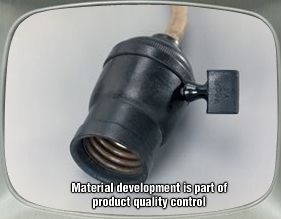Home > Pavilion
Konosuke Matsushita Museum / Material development is part of product quality control
The exterior of the museum building emulates the exterior of the Panasonic headquarters building constructed in 1933. The museum was opened in 1968 to commemorate the 50th anniversary of the founding of Matsushita Electric Housewares Manufacturing Works (now Panasonic). The Konosuke Matsushita Museum traces the historical development of Japan's household appliances industry.
(For more information, see the January 2010 issue of the PR magazine pla-topia.) http://panasonic.co.jp/history/museum/
At the start, natural resins were used but subsequently, phenolic resin that was the first synthetic resin to be made in Japan came to be used. The full fledged start of this usage was in the Key Socket debuted in 1929. In 1934, a urea resin molding material was commercialized. After the war, production of phenolic resin molding materials recommenced in 1946, while that of urea resin molding materials restarted in 1948. Manufacture of melamine resin molding materials started from 1958 and in 1964, production of polyester molding materials started. Polyester glass fiber reinforced types came to be used in home appliances, electronic components, and automobile components.


